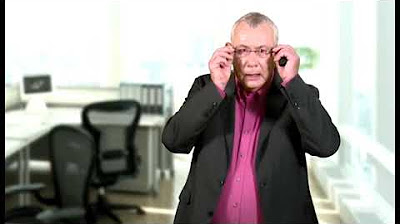Gap Model of Service Quality, Service Marketing, Marketing of services, service gap model
Summary
TLDRThe transcript discusses the critical relationship between customer expectations and perceptions in the context of service quality. It explores how a customer's anticipation of a service, such as dining at a restaurant, can differ from the actual experience, leading to either satisfaction or dissatisfaction. The concept of 'gap analysis' is introduced, explaining how discrepancies between expectations and perceptions result in service quality issues. The transcript also references a framework known as the 'Gap Model,' which helps businesses identify and reduce these gaps, ensuring better customer satisfaction and improved service delivery.
Takeaways
- 😀 Customer expectations are shaped by prior experiences, advertisements, and recommendations. These expectations influence how they perceive a product or service.
- 😀 The **Gap Model of Service Quality** identifies five critical gaps that lead to customer dissatisfaction: Knowledge Gap, Design Gap, Delivery Gap, Communication Gap, and Perception Gap.
- 😀 The **Knowledge Gap** occurs when a company fails to understand or accurately identify customer expectations, leading to mismatched services.
- 😀 The **Design Gap** emerges when the service or product design does not align with customer expectations, even if the company understands them.
- 😀 The **Delivery Gap** arises when the service is poorly executed or fails to meet the expected standards, even when it was properly designed.
- 😀 The **Communication Gap** happens when there's a discrepancy between what is promised in advertisements and what is actually delivered, leading to unmet customer expectations.
- 😀 The **Perception Gap** occurs when customers' perceptions of a service differ from their initial expectations, potentially leading to dissatisfaction even if the service was delivered as promised.
- 😀 To minimize the **Knowledge Gap**, companies should engage in proactive communication with customers and gather regular feedback to align their understanding of customer needs.
- 😀 The **Design Gap** can be minimized by ensuring that services are designed to meet customer expectations, which requires continuous market research and customer feedback.
- 😀 To address the **Delivery Gap**, businesses should focus on proper training for employees and ensure that service delivery matches the design specifications. Regular monitoring and quality assurance are also essential.
Q & A
What is the Customer Satisfaction Gap Model?
-The Customer Satisfaction Gap Model identifies key gaps that can occur between customer expectations and the actual service delivered, which ultimately affect customer satisfaction. These gaps include the Knowledge Gap, Design Gap, Performance Gap, Communication Gap, and Satisfaction Gap.
What is the Knowledge Gap in the context of customer satisfaction?
-The Knowledge Gap occurs when a company fails to fully understand customer expectations. This can happen due to poor market research, lack of customer feedback, or misinterpretation of customer needs.
How does the Design Gap affect service quality?
-The Design Gap happens when a company understands customer expectations but fails to design its services or processes to meet them. For example, a restaurant might know customers expect a variety of dishes, but if the kitchen cannot handle the demand, the service quality suffers.
What is the Performance Gap and how does it manifest?
-The Performance Gap occurs when there is a discrepancy between the service that is designed and the service actually delivered. This gap can result from inefficiencies, poor staff training, or lack of proper resources.
Can you explain the Communication Gap in customer service?
-The Communication Gap arises when there is a disconnect between what a company promises through advertising or communication and what is actually delivered. Over-promising in marketing campaigns and under-delivering in service is a common cause of this gap.
What is the Satisfaction Gap in the context of the model?
-The Satisfaction Gap represents the difference between customer expectations and their actual perception of the service received. If the service does not meet the customer’s expectations, dissatisfaction occurs.
How can companies minimize the Knowledge Gap?
-To minimize the Knowledge Gap, companies should engage directly with customers through surveys, feedback, or direct conversations. This helps management gain a clearer understanding of customer needs and expectations.
What role does proper training play in closing the Performance Gap?
-Proper training ensures that staff are equipped with the necessary skills to deliver services according to the company's standards. Well-trained employees are crucial to reducing the Performance Gap, as they are more likely to meet or exceed customer expectations.
Why is it important to accurately manage customer expectations in communication?
-Accurately managing customer expectations in communication helps prevent the Communication Gap. When customers are promised specific services or benefits that are unrealistic or exaggerated, they are more likely to feel disappointed when the actual service does not meet those expectations.
How can companies reduce the Satisfaction Gap and improve customer loyalty?
-To reduce the Satisfaction Gap, companies should focus on delivering what was promised, continuously gather customer feedback, and make adjustments to meet customer expectations. Consistently meeting or exceeding customer expectations builds trust and loyalty.
Outlines

This section is available to paid users only. Please upgrade to access this part.
Upgrade NowMindmap

This section is available to paid users only. Please upgrade to access this part.
Upgrade NowKeywords

This section is available to paid users only. Please upgrade to access this part.
Upgrade NowHighlights

This section is available to paid users only. Please upgrade to access this part.
Upgrade NowTranscripts

This section is available to paid users only. Please upgrade to access this part.
Upgrade NowBrowse More Related Video

The GAP Model of Service Quality I Services Marketing

Brilliant Customer Service - How to Impress your Customers! - Chapter 2

GAPS MODEL, Gaps of service quality, Gaps analysis, gap models, gap model of service quality, Gap

Tugas Analisis Jurnal Farmasi yang Menggunaakan Statistika Deskriptif

Kepuasan Konsumen

The Environment and Market
5.0 / 5 (0 votes)